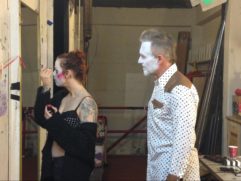The crazy-coiffed, playa-loving troupe lets down its wigs for the Burning Man Journal
In the world of “contemporary drag buffoon cabaret,” there’s no one like Fou Fou Ha. Over the years, you may have spotted the clown troupe roaming the playa in bawdy dress, outrageous makeup and wigs as big as RVs. Or maybe you spied them at Decompression: a rainbow of colors, stripes and curves colliding with slapstick joy, those wigs hanging on to their owners’ heads for dear life.
Who are these darling “fools” (fou is the French word for “crazy”)? We went behind the makeup, under the wigs and through the corsets to find out. What we learned turned out to be far truer than those false eyelashes.

Fou Fou Ha was created and is now lovingly cultivated by “Mama Fou,” aka Maya Lane, a therapist who started the troupe in 2001 as “The Dancing Girls.” The Dancing Girls were not, of course, just girls, and their specialty was choreography with a ridiculous edge — think pirouettes that end in splats. Lane had always loved Bob Fosse and musical theater. She studied in Holland, where she was inspired by European street and circus performance. Later, drag wielded its mighty influence on her, too.
Today there are 15 people in Fou Fou Ha, and everyone makes their own costumes, including a unique signature headpiece. “The wig is your rite of passage,” says Lane. “You must forge your own.”
This is actually a big deal because you aren’t just a part of Fou Fou Ha; Fou Fou Ha is a part of you. Just as clowns exaggerate their moves, so too do the members of Fou Fou Ha, but in this case it’s waaaay more personal. Performers play on and accentuate their own quirks such that their Fou persona is actually an exaggeration of themselves.

“There’s so much that we’re grappling with as humans that we’re ashamed of,” explains Lane. “I see it as very healing to own it and master it, and not let it be something that haunts you, but actually to say, ‘This is something that’s part of me and I celebrate it and accentuate it. I’m not afraid of it and I’m not hiding from it.’ It feels very liberating for a lot of people. And it can be very intense for some people.”
Lane’s persona, Mama Fou, is the mama bear. Her character wants the best for her brood, but she’s also rude, messy and clumsy, and sexualizes everything. “The grotesque really comes out in my Mama, which I’m enjoying more and more,” Lane reveals.
Karena Weil’s Fou is called Punt. Loud, boisterous and enthusiastic, she tries to be a rock star icon but underneath all that bravado she’s deeply insecure and very hard on herself. “The character is based on true parts of me that are amplified and blown up to be absurd. I have come a long way with this stuff, but it is still part of my experience and who I am,” Weil reveals, adding that Punt is also influenced by her teenage self, a “super rowdy, raunchy gutter punk.”

Like Lane, Weil is a therapist, and she sees parallels between being a clown and being in therapy. “They both attempt to examine and embrace all aspects of the human condition, shadow and light, and look at what it means to be human. The process of developing a character based on things you might be ashamed of, or uncomfortable with, and magnifying them to the world is actually really therapeutic.”
That said, Dyon Lain’s character, Fou Real, is less about exaggerating his quirks than stripping them away until all that remains his inner true self. Lain has no formal dance training, but you wouldn’t know it from his regal, swanlike moves. “Dancing gives me an opportunity to relate how I feel without being judged,” he says. When you watch Lain perform, you’re witnessing his inner child bolding stepping into view with definitive “This is who I am.”

“You discover so much about yourself as you go through the process of becoming your alter ego, and moving in and out of that,” says Sarah Wells who plays Cumquat, a highly egoic, vicious flirt who can be a bit of a hot mess. “You learn a lot about the depths of your own psyche, what lies in the hidden corners of your shadow, and your boundaries and limitations. For me, it’s been the understanding of myself that changes, and with it, so does the question of how do I want to present myself. It’s about honoring ALL parts of myself, and thinking in that context, rather than changing anything to fit into a prescribed script or environment.”
It’s kind of funny, then, that to get to this state of freedom and self-actualization, Fous must endure over an hour of makeup and prep before unleashing their bad selves on the world. But it is a process that Wells says brings them closer together. All that time primping also means they have long moments to catch up on life, make jokes, put on music and enjoy each other’s company. Going to Burning Man together is another way they strengthen their family.
“I always look forward to being with my troupe members,” says Wells. “Everyone is so frickin’ talented and different and eccentric. I never thought I would be a part of such a wonderful group of divine tricksters — but here we are.”
(Top photo by Thomas Gould)









Too bad performance troupes and theater projects are specifically excluded from honoraria grants, huh?
Report comment
Hells yeah!! If FFH got a grant to create a show at Burning man we would BRING IT!
Report comment
Looks like it’s time for BRAF to include performance art in its panoply of grants to physical structures!
Report comment
Comments are closed.